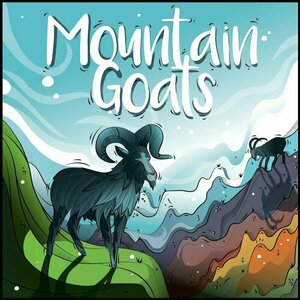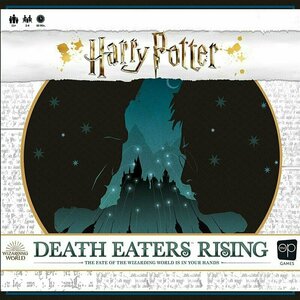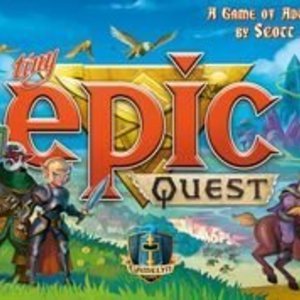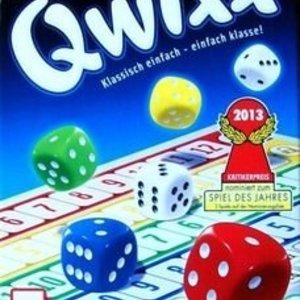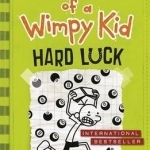
Hard Luck
Book
Greg Heffley's on a losing streak. His best friend, Rowley Jefferson, has ditched him, and finding...

Apocalypse World
Tabletop Game
Apocalypse World is a post-apocalyptic game of sex, violence and death in a wasteland permeated by...
Post-Apocalyptic Powered by the Apocalypse PbtA Roleplaying Mad Max Waterworld
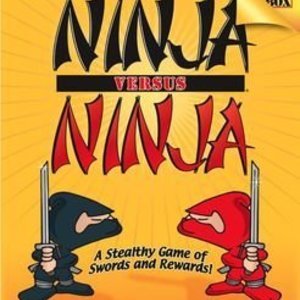
Ninja Versus Ninja
Tabletop Game
A Stealthy Game of Swords and Rewards Your Ninjas must defend the honor of their dōjō against a...
BoardGames NinjaGames
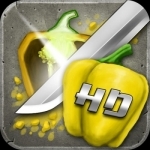
Veggie Samurai HD
Games and Entertainment
App
JOIN OVER 4 MILLION VEGGIE SAMURAI PLAYERS! It's time to give veggies what they have had coming for...
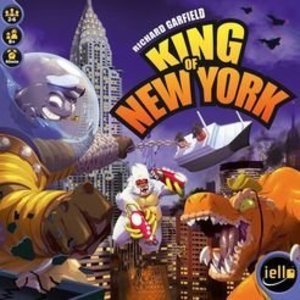
King of New York
Tabletop Game
There's always something happening in the city that never sleeps. Maybe it's the lights, maybe it's...
Purple Phoenix Games (2266 KP) rated Mountain Goats in Tabletop Games
Mar 14, 2021
Mountain Goats is a game in which players are racing to the top of 6 different mountains with their goats, in a bid to be the ‘king of the hill,’ if you will. To setup the game, lay out the Mountain cards into a grid, as described in the rules. Place the point tokens at the top of their corresponding Mountain cards, set the Bonus point tokens to the side, and all players place one Goat meeple at the bottom of each set of Mountain cards. The game is now ready to start.
On your turn, you will roll the 4 dice of the game. Using those results, you will create groups of dice, in which the dice total dictates which of your Goats is moved. Once you have created your groups, you will move your Goat up one space on the corresponding Mountain. (For example, if one of my dice groups is a 3 and a 2, then I will move my Goat on Mountain 5 up one space). After moving all of your affected Goats, pass the dice to the next player. Simple, right? Yep! Now here’s where it gets interesting. If you get a Goat to the top of a Mountain, you will collect a Point token from the corresponding pile. If an opponent is already at the top of a Mountain and you are able to move there, then you kick your opponent back to the bottom of that mountain, and claim the top spot for yourself, collecting a Point token as normal! AND if you create a dice set for a Mountain on which you are already at the top, you get to collect an additional Point token and keep your Goat at the top. How long can you hang onto that top spot? I guess you’ll find out. If/when you collect at least 1 Point token from each of the 6 Mountains, you get to claim the highest-value Bonus point token still available.
Play continues in this manner until either all of the Bonus point tokens have been claimed, or when 3 Mountains have no more Point tokens remaining. Players count up all of their collected points, and the player with the highest score is the winner.
The thing I like about Mountain Goats the most is that it is so fast and easy to play/teach. The concept is easy to grasp, the mechanics are simple, and the gameplay is engaging. So right off the bat, this is a solid game for me. The next thing I like is that even though it is such a small, light game, you’ve still got to have a strategy to succeed. With the Mountains numbered 5-10, you really have to think about how you want to group your dice. If your total falls below 5 or over 10, it won’t move any Goats! So if you’ve got a 6, 6, 5, and 2, how can you best maximize your movement? Are you willing to sacrifice a die because it doesn’t necessarily work with your strategy this turn? Or do you want to move as many Goats as possible every turn? It’s really up to you, and that strategic flexibility heightens the gameplay for me.
The other thing I really like about Mountain Goats is the amount of player interaction, in a sort of take-that way. When you reach the top of a Mountain, if an opponent is already there, they get kicked back to the bottom! So not only do they have to start the climb over again, but they can’t just sit pretty collecting Point tokens when possible. For me, the slight take-that element in this game is more friendly than cutthroat, and that really makes the overall gameplay experience more positive. Starting over from the bottom is, at most, only 4 cards from the top, so getting kicked down isn’t totally detrimental to the game atmosphere.
Components. They’re great! The cards are nice and sturdy, the artwork colorful and numbering clear. The Point tokens are nice thick cardboard, the dice are big and clear, and the Goat meeples are chunky and fun to manipulate. I have yet to see a game from BoardGameTables.com that has poor production quality, and Mountain Goats is no exception.
All in all, I think this is a great and fun little game. The concept is cute, the gameplay itself is fun and engaging, and the small footprint and short playtime make it an enjoyable little game. And since the gist of the game is just counting/numbers, it can be played with relatively young gamers, which makes it a good family-friendly filler game. Purple Phoenix Games gives Mountain Goats an ascending 9 / 12. Give it a shot and see if you’ve got what it takes to come out on top!
Purple Phoenix Games (2266 KP) rated Harry Potter: Death Eaters Rising in Tabletop Games
Dec 3, 2020
Harry Potter: Death Eaters Rising is a game utilizing the Rising system of games (which also includes Batman, Star Wars, and SpongeBob Squarepants as of now) for two to four players. It is a cooperative game where players will take charge of one of the three factions: Dumbledore’s Army, Hogwarts, or Order of the Phoenix in order to defeat Voldemort and his Death Eater cronies. Though Voldemort will be menacing players throughout the game, the players will not be able to attack him directly until about half way through the game. Can you survive long enough to battle the big bad?
DISCLAIMER: We were provided a copy of this game for the purposes of this review. This is a retail copy of the game, so what you see in these photos is exactly what would be received in your box. I do not intend to cover every single rule included in the rulebook, but will describe the overall game flow and major rule set so that our readers may get a sense of how the game plays. For more in depth rules, you may purchase a copy online or from your FLGS. -T
To setup, follow the instructions in the rulebook, but generally the central board will have the large painted Voldemort “mini(?)” and three areas that hold Place cards: Hogwarts, Ministry of Magic, and Diagon Alley. Players will be given one Leader card in their chosen faction (obviously Order of the Phoenix is best) to begin the game. Set aside the damage counters, corruption gem tokens, and Spell tokens in their own piles. Shuffle the main deck of character cards, reveal and place three per Place and then insert the Voldemort card somewhere near half-way into the shuffled deck. The game may now begin.
On a player’s turn they must complete the following steps: 1. Travel to a Location, 2. Roll Voldemort Die and resolve actions, 3. Roll, assign, and resolve Wizard dice, and 4. End Turn. After taking these actions it will be the next player’s turn.
To Travel to a Location, the active player will place their faction-matching Mission token upon one of the Places on the board. This is the Place that the active player may now be able to recruit Wizards from and also attack enemies.
Once at a Location, the active player will Roll Voldemort Die and resolve actions thenceforth. The game affords players a large green Voldemort Die to be rolled. Upon the faces are sides that instruct players to turn the Voldemort mini Left or Right one Place and attack all Wizards there (including all Wizards on a player’s team if Voldemort is now in their Location). Two faces will also show the Dark Mark. When this face is rolled Voldemort does not move, but will attack all Wizards at his current Place (by placing damage counters on the card) as well as activating ALL Death Eater Dark Mark abilities. Not all Death Eaters will have Dark Mark abilities, but when they activate, they can be deadly.
Now that Voldemort has had his fun, the active player will Roll, assign, and resolve Wizard dice. Players will have in front of them faction cards that indicate how many and of which color dice to be rolled on a turn. These dice may be added to or otherwise altered as a result of recruited Wizards’ special abilities as well. Once a player takes the appropriate dice to be rolled, they must roll them and begin assigning faces to Wizards for recruitment, Death Eaters for damage, or other abilities on team cards. Recruiting more Wizards to a player’s team or damaging Death Eaters is how the game progresses because each time a card is recruited or defeated it is removed from the main board and a new card replaces it. As long as at least one die is removed from the player’s pool each time the dice are rolled the player may continue rolling to match symbols needed.
To End Turn, the active player will add any recruited Wizards to their team, discard any defeated Death Eaters, Wizards, or Places, and retrieve their Mission token to be used on the next turn.
Play continues in this fashion of taking turns through the four steps until the Voldemort card is drawn. He then comes into play as an enemy that may be attacked like normal. Players win when they defeat enough Death Eaters and Voldemort, but can lose if the players allow a Place to be completely corrupted (usually by Death Eater card abilities), allowing four Places to be corrupted, if too many Wizards have been defeated per number of players, or any player has all their Wizards defeated from their team.
Components. This game includes a lot of components of varying style and materials. The cards are all very glossy (meh) and feature headshots of the characters mostly. The board is three pieces fit together like a pizza and is great. The damage counters are little translucent red cubes, and the corruption gem tokens are also translucent gems but gray in color. The best components in the game are by far the Voldemort, well, statue and all the dice. The Voldemort piece is incredible, and pre-painted. The stance he is taking is formidable and somewhat intimidating when he’s pointing his wand right at you. The dice have been upgraded to a matte finish (as opposed to yucky polished finish) and feature some great inking. The one negative I have to say is also about the dice: I believe that the faces sometimes can be confusing because the icons are more detailed than is necessary. While some would argue that detailed dice are better than merely serviceable dice, I would much rather see a sword on a face and know it’s a sword than to look at a die face and wonder what I am looking at exactly. In any case, that’s my opinion and yours may be different. Let’s still be friends.
So overall this is a big upgrade over the Thanos version of a Rising game for several key reasons. In Thanos I always felt like every turn could lose the game for us, and Thanos seemed to gain the Infinity Stones too quickly for my taste. In this version, you know you have half a deck before you are able to even fight Voldemort, so being able to tackle his minions until then seems more surmountable. The dice have been upgraded, and the Voldemort die is wonderful and easy to read. That was an issue I had with Thanos: his die was hard to read and the colors were not distinct enough. Not a factor in this version at all. I also feel that this version has much more faction-dependency and interplay. What I mean is that an Order of the Phoenix card may require a player to also have a Dumbledore’s Army card on the team in order to unlock access to their special ability. I like that. I like a well-balanced team, though my first game saw me recruit eight Order of the Phoenix cards and one Dumbledore’s Army card. We won, but I felt bad.
So it’s no surprise that I love this game. I find it better and easier to learn/play than the Thanos version. I like the components a whole lot more. I like the interplay between the factions more. I am sad that I prefer Marvel to Harry Potter, but I do not dislike Harry Potter, let it be known. And I do enjoy this version much more. Purple Phoenix Games gives this one a triumphant 10 / 12. My wife and I truly love it and can’t wait to play it again very soon. If you are looking for a good Rising game, I certainly recommend you look at Harry Potter: Death Eaters Rising. It’s a guaranteed hit if you or a loved one is a Harry Potter fan. For sure. It’s brilliant.
Purple Phoenix Games (2266 KP) rated Tiny Epic Quest in Tabletop Games
Jul 29, 2019 (Updated Jul 9, 2020)
A world at peace has been thrust into chaos once more as mysterious portals have opened across the lands, spewing forth treacherous Goblins! The citizens need heroes – and that is your specialty! Traverse the lands to fight Goblins, learn magic spells, and delve into ancient temples to find powerful artifacts to aid in your battle for good.
Disclaimer: I do not intend to rehash the entire rulebook in this review, but give a general overview of the rules and the gameplay. If you want to read the rules more specifically, pick up a copy of the game at your FLGS or directly from the publisher. – L
Tiny Epic Quest is a game of area movement, dice rolling, and push your luck, in which players are trying to amass the most end-game victory points. How do you earn VPs? By completing quests, fighting Goblins, and learning spells! A game of Tiny Epic Quest is played over 5 rounds, and each round is broken into 2 phases – the Day Phase and the Night Phase. The Day Phase consists of 4 turns where you will can move your heroes. A turn plays out like this: the starting player selects one of the 5 available movement cards and moves 1 hero according to those restrictions. Following clockwise, each other player may move 1 hero in the same manner, or choose to Idle and not move. Once everyone has moved or idled, the next turn starts and play continues as before. After 4 movement cards have been performed, the Day Phase ends.
Moving on to the Night Phase, players have the opportunity to perform the actions associated with the card regions onto which they moved during the Day Phase. If you moved to a Goblin Portal, for example, you now have the chance to fight. On your turn in the Night Phase, you will roll the Adventure Dice and resolve them in an attempt to complete your goals – defeating goblins, completing temples, or learning spells. Quests can be completed in either the Day or Night Phase, depending on the requirements. When you complete a quest, collect the card and hang onto it for end-game scoring. The Night Phase ends when all players have opted to Rest (either by choice or by becoming exhausted), and the round is over. Perform the round resolutions (refill goblin portals, etc.), and then continue on to the next round. After 5 rounds, tally up your VPs, and the player with the most is the winner!
For such a ‘tiny’ game, Tiny Epic Quest definitely has a lot going on. The amount of strategy required for this game is pretty intense. You not only have to decide where to move your heroes, you also have to think about what you want to do and how you want to earn your VPs. Do you want to take a combative approach and try to kill as many goblins as possible? Do you want to try your luck at learning high-level spells? Or is your strategy dictated by the current quest cards in play? Not only do you have to figure out your own strategy, you are also trying to figure out how your opponents are playing as well. Will you try to beat them to a temple first or will you let them do their own thing as long as they don’t interfere with your plans? There is no single right way to play this game, and that’s what makes it so engaging and fun with every play.
That being said, this game also has a fair amount of push your luck in the form of the Adventure Dice. Not all of the die faces are beneficial to you, and they are resolved in a specific order. Damage always is dealt to you first, and if you take too much damage, you immediately become exhausted. When that happens, all of your heroes are returned to your starting castle, and any progress you had made on goblin fights, temple tracks, or spell-learning is lost. You really have to be thinking about how far you are willing to go, and if it is worth one more roll of the dice to risk success or complete failure.
Tiny Epic Quest is kind of a double-edged sword for me. I enjoy games that require decent strategy, but I also am not too fond of push your luck games. This game can sometimes feel like it’s working against you – all of your strategic setup in the Day Phase could be undone with some unfortunate dice rolls in the Night Phase. No matter how solid your strategy is, the dice will ultimately seal your fate. Don’t get me wrong, part of the fun of Tiny Epic Quest is figuring out how to bounce back after a poor Night Phase. But dice can be brutal sometimes and that can take away from your enjoyment.
So where does Tiny Epic Quest fit into the family? I would say it’s a cousin that you like, but don’t see too often. I enjoy playing this game from time to time, but it is definitely not my go-to Tiny Epic game. The rulebook could use some simplification, and for being a Tiny Epic game, it is kind of a table hog. Some of the strategy for me is negated by the dice-rolling mechanic, but it could also be because I am a notoriously bad dice roller… Would I recommend Tiny Epic Quest? Ultimately, yes I would. I may not personally like some of the aspects of play, but the game itself is engaging and entertaining. If you haven’t checked this one out yet, give it a shot! Purple Phoenix Games gives Tiny Epic Quest a valiant 9 / 12.
Purple Phoenix Games (2266 KP) rated Qwixx in Tabletop Games
Aug 12, 2020
The object of Qwixx is to be the player who earns the most amount of points at the end of the game. Simple. The game can end at any time in the future, so it is a furious scramble for points on each player’s turn.
To setup, hand each player a score sheet and a writing utensil (not included). Roll off to determine starting player. You are now ready to play Qwixx.
On the active player’s turn, they will roll all available dice. The player will add up the numbers rolled on the two white dice and announce to the table the sum. Using this summed number, all players (including the other non-active players) may cross off this result in any row upon their score sheet. Then the active player may add the result of ONE of the white dice to any of the other-colored dice results to use for their own score sheet. So the active player has the opportunity to cross off two numbers on their score sheet on their turn.
You see, to earn endgame points players are attempting to cross off as many numbers on their score sheets as possible. The caveat follows, however, that once a number has been crossed off within a row a player may NOT cross off any lower numbers than the highest number crossed off. Example: if I were to first cross off a 4 in the red row, I may never cross off 1, 2, or 3 of red in the future. Those options are now lost to me.
Caveat ludio! Players beware! At any time a player can “lock” a color row and remove that color die from the game. This can be done by crossing off the 12 box on the sheet. The prerequisite for this action is to have five boxes crossed off in that row. Also, should a player be unable to cross off a number on their turn, they must cross off one of the penalty boxes on their sheet for a loss of 5 points at endgame. The game ends when a player has crossed off all of their penalty boxes or players have locked the second colored row.
Components. This game is a few dice and a pad of score sheets. The dice are of normal d6 quality. The score sheets are fine, but if you really love this game, you might think about laminating some and keeping some small dry/erase markers in the box. The magnetic flip box is the coolest component of this game and you don’t really use it for anything other than storage!
So here are my thoughts on Qwixx. It is not the most exciting game. It is also not a bad game at all. It is a solid filler that can be played while carrying on a conversation (if you feel you can actually chat and math simultaneously). I don’t think I will suggest it be played too often, but if I am jonesin’ for a quick roll-and-write with a couple other people, or if I have a large game day scheduled, I will throw it in one of my bags. I am not alone on this assessment as you can see from our scores, and for these reasons Purple Phoenix Games gives Qwixx a midline 16 / 24. I think you can easily find this at Target or the like for a reasonable price, if this sounds interesting to you.
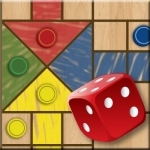
Classic Ludo Offline & Online
Games
App
NEW: Multiplayer Online with Facebook Friends available now. Calling all the kings of Ludo game,...
